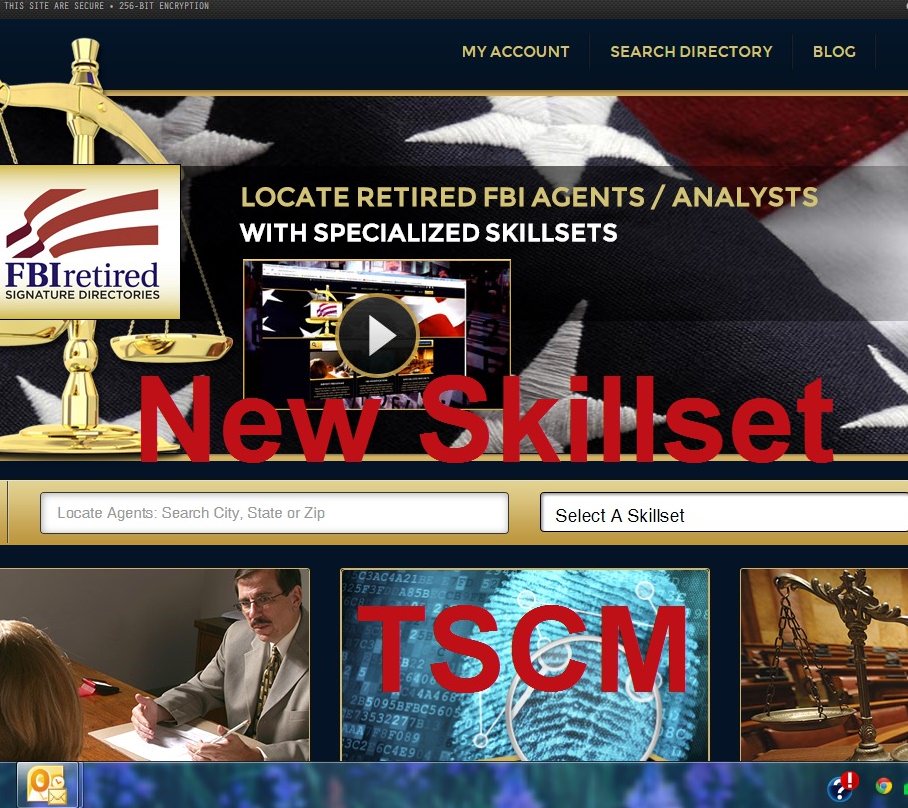October 10, 2014
TECHNICAL SURVEILLANCE COUNTER MEASURES [TSCM] ADDED AS SKILLSET!

SACRAMENTO–Technical Surveillance Counter Measures also known as TSCM surveys have been added to the website as a new skillset for members whose services include conducting electronic sweeps–looking for illegal eavesdropping devices or “bugs.” TOM GIBBONS, a founding member of The TSCM Network, an affiliation of retired FBI Agents providing TSCM services, said the skillset would better define agents offering Technical Surveillance Counter Measures [TSCM] services, as well as encourage membership.
Law enforcement use special electronic devices or “bugs” to intercept, capture and record electronic signals, i.e. data, video and voice communications conducting investigations warranting Title III electronic surveillance. The “bugs” capture information transmitted through the air as radio waves. Unless authorized by the Attorney General [AG] and approved by a Federal District Court, using a “bug” in the United States is illegal and can warrant federal investigation and possible prosecution. Seeking to conduct a Title III electronic surveillance conducting a criminal investigation, an originating law enforcement agency must submit an affidavit supporting its application first to the Justice Department for review and then later a District Court for approval—detailing an investigation and justifying the surveillance.
Looking for illegal “bugs,” the FBI employs a cadre of specially trained agents to conduct Technical Surveillance Counter Measures [TSCM] in an effort to locate the concealed contraband and prosecute individuals using them. Not unlike foreign agents who use the devices to conduct espionage and/or spy on Government facilities to get information, thieves use illegal “bugs” to steal intellectual property and/or secret processes and jilted lovers have employed the craft wanting to rekindle an old romance or sometimes exact revenge.
To make sure an environment is free of “bugs,” the FBI uses Technical Surveillance Counter Measures [TSCM]–techniques employed by skilled tech agents–to uncover “not” only illegal eavesdropping devices, but hazards and security weaknesses that could result in a facility’s penetration. Wanting to make sure facilities are “bug” free, FBI offices are mandated to conduct TSCM surveys using Technical Surveillance Counter Measures [TSCM] so managers can make year-end certifications validating an office’s technical security, requiring thorough examinations employing special electronic equipment, as well as visual inspections and hands-on physical searches.
Employing Technical Surveillance Counter Measures [TSCM], tech agents look for “unexplained” radio waves emanating from a facility or being directed to a facility, using Radio Frequency [RF] receivers. Only quality lab and field RF receivers should be used conducting the TSCM surveys which are expensive to purchase and require a working knowledge of RF theory to operate. Because the equipment is expensive retired FBI agents interested in establishing a security business conducting Technical Surveillance Counter Measures [TSCM], sometimes share equipment, doing business as limited partners.
Included among the pieces of technical equipment used by agents conducting Technical Surveillance Counter Measures [TSCM] are: 1.] Multimeters to measure power supply and device components; 2.] Time-Domain Reflectors [TDRs] to test the integrity of copper telephone lines and other communication cables; 3.] Frequency Scanners with antennas and filters used for checking the electromagnetic spectrum for “unexplained” signals; 4.] Oscilloscopes for visualizing signals; 5.] Spectrum Analyzers and Vector Signal Analyzers for more advanced analysis of threatening and non-threatening RF signals; 6.] Nonlinear Junction Detectors [NLJDs] for detecting components associated with hidden eavesdropping devices; 7.] Portable X-Ray machines for checking devices that might be hidden inside objects and walls; 8.] Computer Security Devices & Tools for computer related threats; 8.] Tools for disassembling objects and walls looking for illegal devices; and 9.] Thermal Imaging Devices to assist identifying concealed “active” devices.

